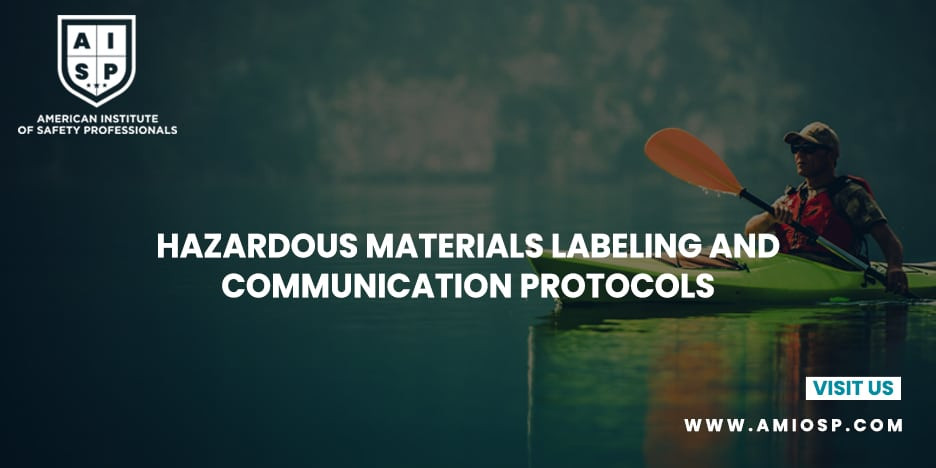Labeling and effective communication are critical aspects of
safely handling hazardous materials. Proper labeling ensures that employees,
emergency responders, and other stakeholders are aware of the hazards
associated with these substances and can take appropriate precautions. In this
blog post, we will delve into the importance of hazardous materials labeling,
the key elements of effective labeling, and the communication protocols that
should be followed to ensure the safe handling of these materials.
Introduction: The Significance of Hazardous Materials
Labeling
Hazardous materials labeling serves as a visual
communication tool that conveys important information about the hazards,
precautions, and handling requirements of a substance. Labels play a crucial
role in identifying the contents of containers, packages, and storage areas,
enabling individuals to take the necessary safety measures. They are vital for
maintaining compliance with regulations, preventing accidents, and protecting
the well-being of workers and the environment.
Regulatory Framework: Understanding Labeling
Requirements
Various regulatory bodies, such as the Department of
Transportation (DOT), the Occupational Safety and Health Administration (OSHA),
and international organizations like the United Nations (UN), have established
specific labeling requirements for hazardous materials. These regulations
outline the elements that must be included on labels to ensure effective communication.
Common labeling requirements include hazard symbols, signal words, hazard
statements, precautionary statements, and product identifiers. Familiarizing
oneself with the specific regulations applicable to your region or industry is
crucial to ensure compliance.
Hazard Communication Standard: The Globally Harmonized
System (GHS)
The Globally Harmonized System of Classification and
Labeling of Chemicals (GHS) is an internationally recognized framework for
hazard communication. It provides standardized criteria for classifying hazards
and a harmonized format for labeling hazardous materials. The GHS includes
pictograms, signal words, hazard statements, and precautionary statements that
contribute to consistent communication across borders and industries.
Understanding the GHS and adopting its principles enhances safety and promotes
global consistency in hazardous materials labeling.
Key Elements of Effective Labeling:
a) Product Identifier: A product identifier is a
name, code, or other means of identifying the hazardous material. It should be
specific to the substance and clearly stated on the label to ensure proper
identification.
b) Hazard Pictograms: Hazard pictograms are
standardized symbols that represent specific types of hazards associated with a
substance. They provide visual cues to quickly convey the nature of the hazard.
Pictograms should be prominently displayed on labels to capture attention and
raise awareness.
c) Signal Words: Signal words, such as
"Danger" and "Warning," are used to indicate the level of
severity of a hazard. "Danger" is used for more severe hazards, while
"Warning" is used for less severe hazards. Signal words help
individuals quickly assess the potential risks associated with the material.
d) Hazard Statements: Hazard statements describe the
nature of the hazard, such as flammability, toxicity, or corrosivity. They
provide specific information about the potential risks associated with the
material, enabling individuals to take appropriate precautions.
e) Precautionary Statements: Precautionary statements
provide guidance on how to handle, store, and dispose of hazardous materials
safely. They offer instructions on protective measures, first aid,
firefighting, and spill response. Precautionary statements ensure that
individuals have the necessary information to mitigate risks effectively.
Communication Protocols:
In addition to proper labeling, effective communication
protocols are crucial for the safe handling of hazardous materials. Clear and
consistent communication ensures that everyone involved understands the risks,
precautions, and emergency response procedures. Some important communication
protocols include:
a) Safety Data Sheets (SDS): Safety Data Sheets
contain comprehensive information about the hazards, composition, handling, and
emergency response procedures for hazardous materials. Employers are required
to make SDS readily available to employees to ensure they have access to
detailed information.
b) Training and Education: Regular training and
education programs are essential to familiarize employees with the hazards
associated with hazardous materials and the proper handling procedures.
Training should cover the interpretation of labels, understanding SDS, and
effective communication of hazards in the workplace.
c) Workplace Signage: Clear signage and placarding in
storage areas, transport vehicles, and other relevant locations reinforce the
importance of proper handling and alert individuals to the presence of
hazardous materials. Signage should be easily visible and consistent with the
labeling system.
d) Supervisor-Employee Communication: Supervisors
should communicate hazards and precautions to employees, provide guidance, and
address any questions or concerns. Encouraging an open line of communication
fosters a safety-conscious culture and ensures that employees are aware of
potential risks.
Benefits of Effective Labeling and Communication:
Implementing effective hazardous materials labeling and
communication protocols offers several benefits, including:
a) Enhanced Safety: Clear and accurate labels,
coupled with effective communication, improve safety by ensuring that
individuals are aware of the hazards and can take appropriate precautions.
b) Regulatory Compliance: Proper labeling and
communication protocols help organizations comply with relevant regulations,
reducing the risk of fines, penalties, and legal issues.
c) Emergency Preparedness: Effective communication
protocols, including clear labels and comprehensive SDS, aid in emergency
response planning and enable prompt and efficient action during incidents.
d) Risk Reduction: Improved communication of hazards
allows for better risk assessment and risk management, minimizing the
likelihood of accidents, injuries, and environmental damage.
Conclusion: Prioritizing Effective Labeling and
Communication
Hazardous materials labeling and communication protocols are
crucial for ensuring the safe handling, storage, and transportation of these
substances. By adhering to regulatory requirements, adopting the principles of
the GHS, and implementing effective communication strategies, organizations can
significantly enhance workplace safety, reduce risks, and protect their
employees and the environment. Clear labeling and open communication contribute
to a culture of safety and compliance, where everyone is well informed and
empowered to handle hazardous materials responsibly.












0 comments
No Comments